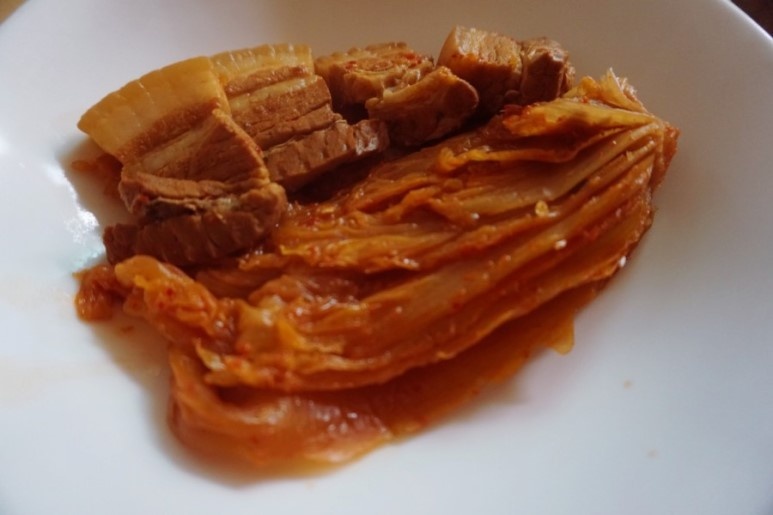Super Simple Pork and Aged Kimchi Stew
Simple Pork and Aged Kimchi Stew Recipe Using Leftover Bossam Pork

Don’t let leftover bossam (boiled pork) go to waste! Transform it into a delicious and incredibly easy ‘Pork and Aged Kimchi Stew’. This recipe is perfect for singles, those living alone, or anyone looking for a quick, minimal-ingredient meal. It requires no special grocery shopping and delivers a deeply satisfying flavor, combining the tangy zest of aged kimchi with savory pork. It’s a guaranteed rice-lover’s dream!
Main Ingredients- Leftover bossam pork from the previous day (or pork belly, pork neck, etc.)
- Aged kimchi: 1/4 head to 1/2 head
Seasoning Mix- 2 Tbsp soup soy sauce (ganjang)
- 2 Tbsp sugar (adjust according to the kimchi’s sourness)
- 1 Tbsp minced garlic (using a ‘be.raspoon’ – standard tablespoon)
- 1.5 Tbsp doenjang (Korean soybean paste) (using a ‘be.raspoon’ – standard tablespoon)
- 2 Tbsp gochugaru (Korean chili flakes) (using a ‘be.raspoon’ – standard tablespoon)
- 2 Tbsp soup soy sauce (ganjang)
- 2 Tbsp sugar (adjust according to the kimchi’s sourness)
- 1 Tbsp minced garlic (using a ‘be.raspoon’ – standard tablespoon)
- 1.5 Tbsp doenjang (Korean soybean paste) (using a ‘be.raspoon’ – standard tablespoon)
- 2 Tbsp gochugaru (Korean chili flakes) (using a ‘be.raspoon’ – standard tablespoon)
Cooking Instructions
Step 1
Prepare the leftover bossam pork from the previous day. Take out the pork that was stored in a disposable plastic bag in the refrigerator. Have your aged kimchi ready as well.

Step 2
Now, let’s make the delicious seasoning mix! First, add 2 tablespoons of soup soy sauce.

Step 3
Next, add 2 tablespoons of sugar. The sugar is added to balance the tangy flavor of the aged kimchi, enhancing its overall deliciousness. Adjust the amount of sugar based on how sour your aged kimchi is. My family’s kimchi tends to be a bit sour, so 2 tablespoons of sugar worked perfectly for us.

Step 4
Add 1 tablespoon of minced garlic (measured with a ‘be.raspoon’, which is a standard tablespoon).

Step 5
Incorporate 1.5 tablespoons of doenjang (Korean soybean paste) (measured with a ‘be.raspoon’) for a rich, savory depth.

Step 6
If you prefer a spicier kick, add 2 tablespoons of gochugaru (Korean chili flakes) (measured with a ‘be.raspoon’).

Step 7
Mix all the seasoning ingredients together with a spoon until well combined. This completes your flavorful seasoning mix!

Step 8
Layer the aged kimchi at the bottom of a pot. I used about 1/4 of a kimchi head, but you can adjust the amount. It’s recommended to keep the kimchi leaves whole, as they retain a better texture and appearance when served later.

Step 9
Place the prepared bossam pork on top of the kimchi. If you like it spicier, you can also add some Cheongyang chili peppers at this stage. (Chili peppers are optional.)

Step 10
Add just enough water to partially cover the ingredients. Adding too much water can dilute the flavor, so be mindful of the quantity.

Step 11
Stir in the prepared seasoning mix, distributing it evenly. Bring the stew to a rolling boil over high heat. Once boiling, reduce the heat to medium-low and let it simmer until the liquid reduces. I prefer my kimchi very soft and thoroughly cooked, so I simmered it for about 40 minutes. However, you can achieve a delicious result by simmering for at least 25 minutes.

Step 12
During cooking, if you find the stew is not salty enough, mix 2 parts water with 1 part soup soy sauce and gradually add this mixture to adjust the seasoning. If the kimchi is too sour, add an extra tablespoon of sugar and about half a cup of water, then continue to simmer to balance the acidity.

Step 13
Once cooked, transfer the kimchi and pork to a serving bowl, cutting the kimchi into bite-sized pieces as desired. Serve it generously with the pork. This dish alone is so delicious that you can easily finish a bowl of rice without any other side dishes! It’s truly a rice thief.




